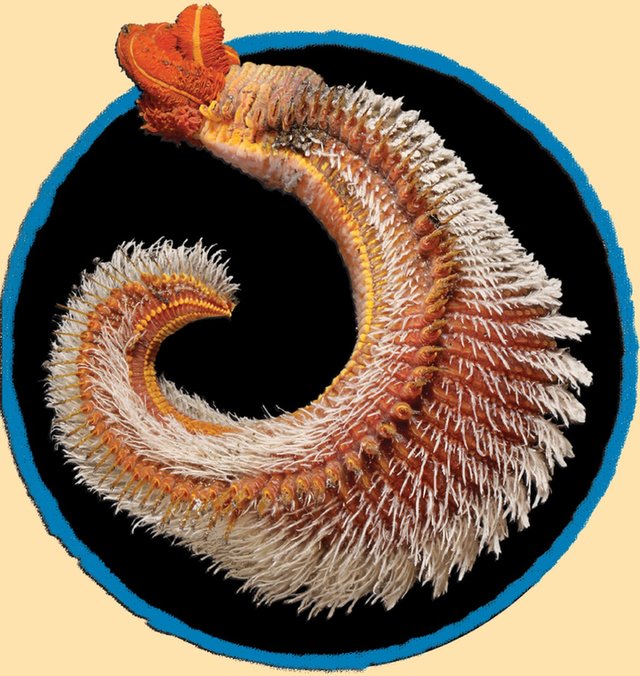HottestLifestyle
DeepinthePacificOcean,therearecracksinEarth’scrustthatbelchhotlavaintothesea.Thecracksarecalledhydrothermalvents,andtheyareprobablythemostextremeenvironmentsontheplanet.Thereisnolightatthisdepth.Thewaterpressureisenoughtocrushaperson.Thewatertemperatureisscalding.AndthisiswherethePompeiiwormmakesits home.
Pompeiiwormsliveincolonies.Anchoredontube-likechimneysthatformoverthevents,thewormsswayinthehotwater.Theyadaptedinaninterestingwaytobeattheheat.Theyuseawinningcombinationofmucusand bacteria.
Thewormsdischargeablanketofthickmucusallovertheirbodies.Itoffersafoodsourceforheat-resistantbacteria.Bacteriaswarm,devourthemucus,andliveontheskinoftheworms.Togetherthemucusandbacteriaactasakindoffirefighter’sblanketthatshieldsthewormsfrom heat.


Pompeiiwormsdon’tmindtheheat.
They’veadaptedtolivenearhydrothermal vents.
Biggest Chill
AwoodfrognestlesunderfrozenleavesandfrostygrassinAlaska.Winteriscoming.Thetemperaturedrops.Thefrog’sheartbeatslows.Ittakesitslastbreathandfreezessolid.It’snot dead!


Atthefirstsignoffreezingtemperatures,NorthAmericanwoodfrogstakeextrememeasurestosurvive.Theirheartsslowdownandactuallystopbeating.Theystopbreathing.Theirbodiesfreezerock solid.Thesefrogsicleslookdead,butthey’re not.
Mostanimalsdiewhentheygettoocold.Ificeformsinsidecells,thecellsburst,andtheanimalcroaks.Butawoodfrog’sbodyproducesahighlevelofsugarinitsblood.Thesugaractsasanantifreeze.Itprotectsthefrog’sorgansfromdamagebynotallowingicetoforminsidecells.Therestofthefrog’sbodilyfluidsturntoiceinthespacesbetweenthecells.Itdoesn’tharmthecellsortheanimal.Whenspringarrives,thefrogthaws,anditsheartbeatandbreathingreturn.Thefrogisasgoodas new!
Woodfrogsfreezesolidbutdon’tdieduringthewinterin Alaska.
MostBizarreDefense
Lyinginthedesertsandlikeaspikyrock,theTexashornedlizardismotionless.ThislizardisafavoritefoodoflotsofhungrycreaturesinthedesertsofthesouthernUnitedStatesandMexico—frombirdstosnakestobobcatstocoyotes.Overtime,ithasdevelopedsomeuniqueadaptationsfor survival.
Anearbycoyoteliftsitsnoseandsmellstheair.Itturnsandspotsthelizard.Somuchforcamouflage.Luckily,theTexashornedlizardhasotherwaystodefenditself.Asthecoyoteapproaches,thelizardhissesandpuffsuptomakeitselflook bigger.
Thecoyoteisunimpressed.Itpouncesandpinsthelizardtotheground.Desperatetimescallfordesperatemeasures.Thelizardlaunchesitsextreme defense.
Texashornedlizardscanreallysurprisepredatorswhentheysquirtfoul-tastingbloodfromtheir eyes.
Asthecoyotecomesintobite,thelizardstraightensupandlooksrightatit.Thecoyote’smouthisopenandthelizardsquirtsastreamofnasty-tastingbloodfromitseyesrightintothecoyote’smouth.Thisdefensewasadaptedspecificallytodeterattacking coyotes.
Here’showitworks:Apocketbehindthe lizard’s eyesfillswithblood.Thelizardsqueezesthepouchandsquirtstheblood.Thebloodcontainschemicalsthattastedisgustingto predators.
Thecoyoterecoils.Itshakesitshead,coughs,andrubsitsmuzzleontheground.Thelizardskittersto safety.
Whetherthey areusingsurprisinghuntingstrategies,findingwaystoliveindangerousenvironments,oravoidingbeingeaten,someanimalsrelyonextremeadaptationsto survive.
